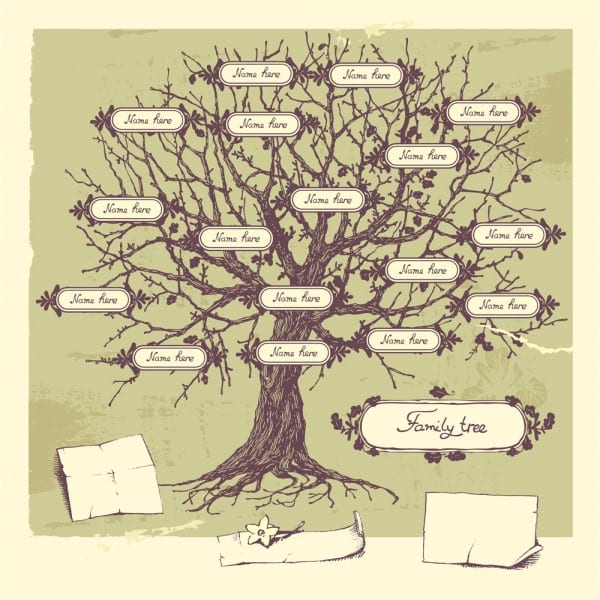As a beginner in genealogy, you may have found several family trees online that appear to relate to your ancestors, or they include many of the same names. The details seem more or less right with what you have found to date, although perhaps a few names do not quite match, and you did not think your great grandmother had that many children… But still, they could be your ancestors, and it looks like them. Yes, William and Susan Morris in 1850 Pennsylvania USA, or George Bunn in 1861 Dudley, Worcester, England. But are these your ancestors -? How can you tell for certain? Here are three general points regarding copying online trees into your genealogy.
#1 Quality Sources.
First you need to see a quality source for the relationships between people in the family tree online. If there is no source or document proving the relationships, then all details are suspect. And, do NOT assume accuracy simply because there are 18 individuals listing these very same names/dates/places online. Seventeen people may have simply copied one tree that someone uploaded 8 years ago and never corrected – and no one tried to find any sources! This is a major error in genealogy!
Look for original quality primary source material to identify and confirm the relationships between these ancestors and yours. In other words, search for original documentation of births and marriages in particular. Remember that Primary sources are those items which were developed at the time of an event: e.g., a birth registration, or a marriage record, or parish record.
Secondary sources may help to confirm information, and you will need to evaluate the accuracy of details, e.g., from a census, comparing those details to the online tree you have found. More examples, such as a census, a draft card, a gravestone, a village history: all of these may provide you with some details you can compare to online trees. Follow the individual details to see if it is possible that the online tree individuals are actually your ancestors, or not. They will help you evaluate the accuracy of the trees you have found online.
#2 Names, Names, and more about Names.
Spelling was weird and wonderful for many years, as few individuals were educated and literate. By the early to mid-1850s, most people could read and write, and spelling of names became standardized. This means you may need to be somewhat creative about how your ancestors may have spelled their names, both first names and surnames. Someone is not necessarily NOT in your tree because they spelled their surname differently from your parents, nor are they necessarily IN your tree simply because they spell it the same!
Naming patterns may help you evaluate whether a family tree contains your ancestors. For example, it was relatively common to follow a naming pattern in the 1700 and 1800s: e.g., first son named for father’s father, first daughter named for mother’s mother, second son named for mother’s father, second daughter for father’s mother. But sometimes, children were named after the father or mother’s siblings – a very common practice, making it quite challenging to follow the ‘correct’ ancestors!
Maiden names of mother or grandmother (on either side) may be incorporated into a first name or middle name – a great clue to follow. If you see a very unusual first or second name, check to see if it shows up a generation or two back; e.g., Arthur Aiken Lewis – that Aiken looks like a surname to me… Yes, his mother’s maiden name. Another example: Whitehead Joyner… again, that Whitehead looks like a surname, and indeed it was – his mother’s maiden name. Grover Buell… surname? Yes, but I had to go back 4 generations to find the Grover! And in the intervals, there were many many Grover Buell individuals who were likely cousins as well as direct ancestors – very confusing.
And, you will likely find that families tended to use fairly similar names from one generation to another. If your 3rd great grandparents named their children George, John, Joseph, Mary, Ann, Elizabeth, etc. – then if you find the online tree contains the next generation children named Carson, Octavius, Elijah, Nancy, Lucinda, Isabella – something does not match, and it is possible that this online tree is not “yours” because the patterns are quite different. It is not always true, but in general, families tended to follow similar name groupings for their children.
#3 Surname Family Associations.
These are wonderful – and highly variable, as well. Check to see if any of your ancestor surnames have an association online which has high quality research on family lines. Either search for a “surname+family association”, or go to the Guild of One Name Studies, and search through there. Actually, I usually do both, as some surname associations are quite small and run by only one individual. By checking online, I was able to confirm many details of ancestors in several lines: Terwilliger, Graves, Merwin, Rice, White, Vineyard.
Also look for histories published on individuals (e.g., Miles Merwin association), on villages, counties, and more for additional details you can use to confirm or discard online family trees as your ancestors. For example, I was able to trace one line of Rice individuals to a Edmund Rice association… but noticed that his grandson married the granddaughter of a Mayflower descendant! Both lines had excellent documentation and the connection was quite clear – amazing serendipity.
As you can see, there are some pitfalls as well as wonderful possibilities in following online family trees for your ancestors. Never take someone else’s online tree as correct, until you have evaluated the sources of their information for yourself. By taking time to confirm the details, you can be more sure of the accuracy of your final tree, and be very proud of your work.

